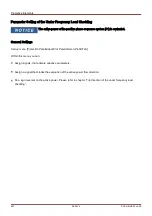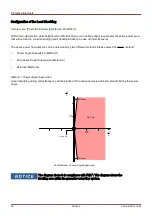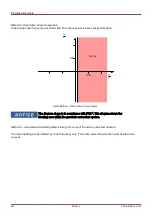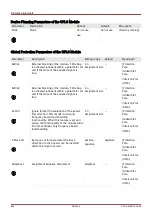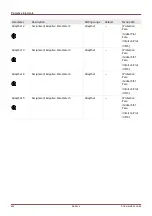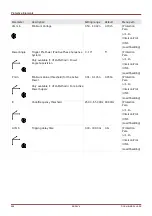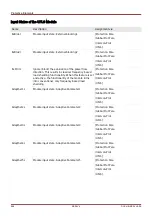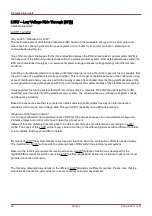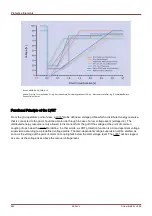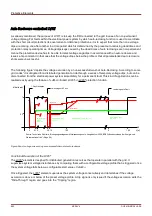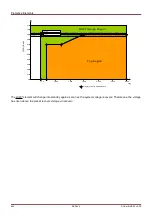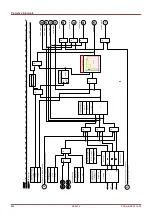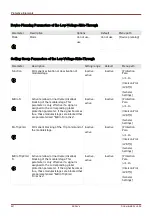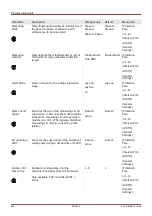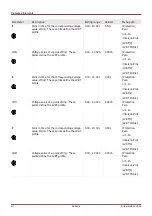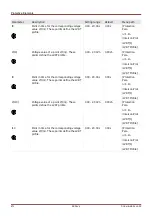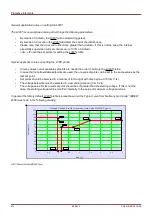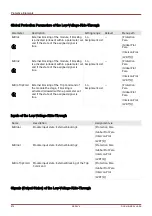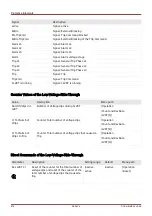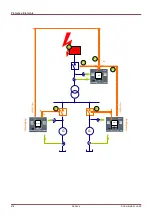
Protective Elements
Auto Reclosure controlled LVRT
As already mentioned, the purpose of LVRT is to keep the DR connected to the grid in case of a non-permanent
voltage dip/sag. For faults within the electrical power system by which auto-reclosing function is used to coordinate
with the short circuit protections like overcurrent or distance protections, it is to expect that more than one voltage
dips are coming one after another in a time period which is determined by the preset auto-reclosing dead times and
protection relay operating times. Voltage dips/sags caused by the dead times of auto reclosings are non-permanent.
Hence the protective device has to be able to detect voltage sags/dips in accordance with an auto reclosure and
issues a trip command in that case that the voltage drops below the profile or that all parameterized auto reclosure
shots were unsuccessful.
The following figure
1
depicts the voltage excursion by an unsuccessful two-shot Auto-Reclosing. According to some
grid codes
1
it is obligated for a distributed generation to ride through a series of temporary voltage dips, but can be
disconnected from the electrical power system immediately for a permanent fault. This kind of applications can be
realized easily using the feature of »
AR-controlled LVRT« in LVRT protection function.
Figure: Run of voltage curve during an unsuccessful two-shot auto reclosure
Functional Description of the LVRT
The
LVRT element is designed for distributed generation resources that operate in parallel with the grid. It
supervises system voltage disturbances by comparing them with a configurable voltage profile that is triggered once
the system voltage falls below a configurable start value »
Vstart<«.
Once triggered, the
LVRT element supervises the system voltage consecutively and determines if the voltage
excursion is above or below of the preset voltage profile. A trip signal is only issued if the voltage excursion exits the
“Ride-Through” region and goes into the “Tripping” region.
963
MCDLV4
DOK-HB-MCDLV4-2E
1
0.3
V/Vn (in pu)
0
0.15
0
0.15
t [s]
1.00
1.00
0
1. Fault Inception
re-closing onto Fault
re-closing onto Fault
Borderline 1
Borderline 2
AR-Dead time, typical : 15s - 20 s
typical tripping-times:
0.1s - 10 s
typical tripping-times:
0.1s - 10 s
AR-Dead time,
typical:
0.3 s - 2 s
Source: Technische Richtlinie , Erzeugungsanlagen am Mittelspannungsnetz, Ausgabe Juni 2008, BDEW Bundesverband der Energie- und
Wasserwirtschaft e.V. (Page 89).
Summary of Contents for HighPROtec MCDLV4
Page 3: ...Order Code Order Code 3 MCDLV4 DOK HB MCDLV4 2E...
Page 47: ...Installation and Connection 47 MCDLV4 DOK HB MCDLV4 2E...
Page 164: ...Input Output and LED Settings 164 MCDLV4 DOK HB MCDLV4 2E...
Page 433: ...Parameters 433 MCDLV4 DOK HB MCDLV4 2E...
Page 457: ...Device Parameters 457 MCDLV4 DOK HB MCDLV4 2E...
Page 473: ...Blockings 473 MCDLV4 DOK HB MCDLV4 2E...
Page 988: ...Protective Elements 988 MCDLV4 DOK HB MCDLV4 2E P P Q P Q P Q Q Q P S S...
Page 989: ...Protective Elements 989 MCDLV4 DOK HB MCDLV4 2E Pr Q P Q P Qr...
Page 1023: ...Protective Elements 1023 MCDLV4 DOK HB MCDLV4 2E...


